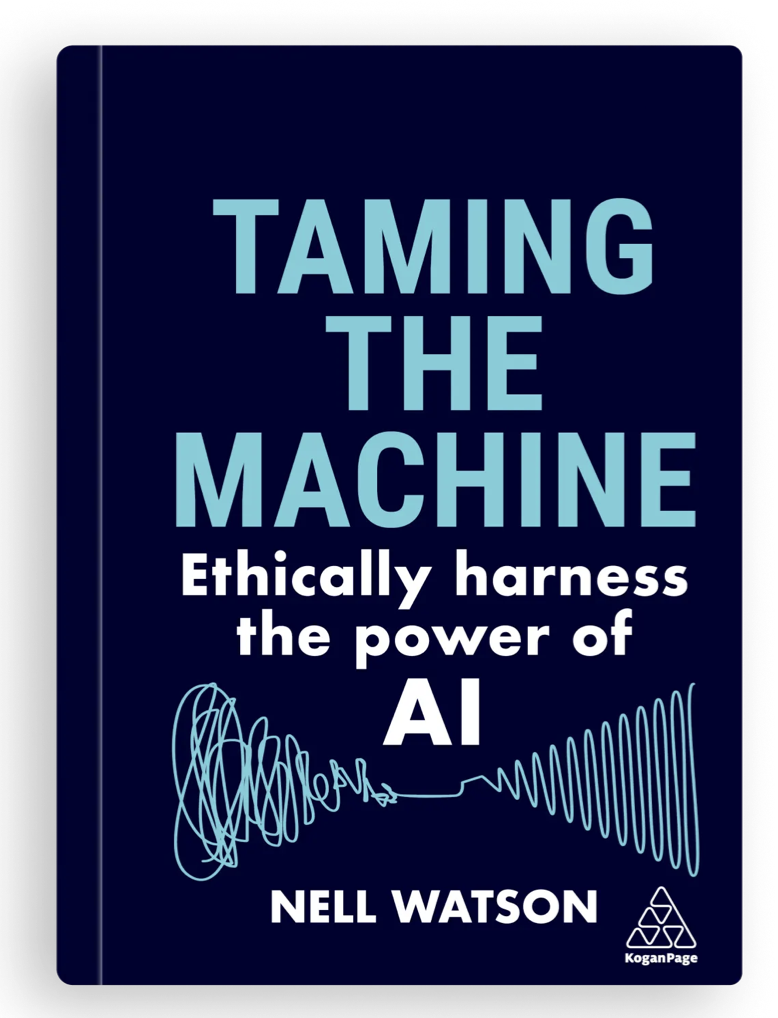AI promises to transform our world, supercharging productivity and ushering in groundbreaking innovations. Yet, headlines rife with AI scandals starkly remind us of its double-edged nature. Taming the Machine is your essential guide to harnessing the colossal power of AI responsibly, shielding your loved ones, businesses, and society from its darker facets.
Discover pragmatic insights on safeguarding sensitive data, steering algorithm-driven leadership, and fortifying cybersecurity. More than a technical primer, Watson deftly unveils the hidden perils of unbridled AI, spotlighting its looming challenges to human morale and societal harmony, especially as we edge closer to an era of machine dominance.
Taming the Machine is a must-read for technologists, policymakers, business leaders, and AI enthusiasts keen to grasp and navigate the seismic shifts AI manifests. Join Watson in sculpting an AI-driven future that magnifies our strengths, yet stays true to our non-negotiable values.
book Contributions
Dear Entrepreneur: Letters from Those That Have Made it And Are Making It Happen by Danny Bailey & Andrew Blackman. Chapter: Open Hand – Published in English by Harriman House.
After Shock: The World's Foremost Futurists Reflect on 50 Years of Future Shock—and Look Ahead to the Next 50, edited by Jon Schroeter. Chapter: ‘Externality Governance’, Published in English by John August Media & Technica Curiosa.
Humankind 2.0 by Jinxia Niu, edited by James Yan – Published in Mandarin by Citic Press.
Exponential Transformation by Salim Ismail et al – Published in English by Diversion Books.
Resilient Health: Leveraging Technology and Social Innovations to Transform Healthcare for COVID-19 Recovery and Beyond, Chapter: Intelligent virtual agents for current and emerging public health crises with Dr. David Luxton – Published in English by Elsevier.
50:50 - Scenarios for The Next 50 Years by Rohit Talwar et al – Published in English by Fast Future Publishing.
Radical Visions of Future Government, Chapter Automated Externality Accounting, Published in English by NESTA.
The Transhumanism Handbook – Chapter: Humanising Machines – Published in English by Springer.
Utopia for Beginners & Utopia for Executives, by Menno van Doon, Sander Duivensteen, and Thijs Pepping, Published in English by Sogeti.
Artificial Superintelligence: Coordination & Strategy – Chapter: The Supermoral Singularity – Big Data & Cognitive Computing, Special Edition.
Aftershocks and Opportunities: Scenarios for a Post-Pandemic Future – Chapter: Retroshock. Published in English by Fast Future Publishing.
Flourishing Futures From COVID-19, Published in English by The Foresight Institute.
Guide to Responsible Tech – Contributor, David Ryan Polgar et al.
Artificial Intelligence and Inclusive Education – Chapter: Towards Inclusive Education in the Age of Artificial Intelligence: Perspectives, Challenges, and Opportunities, with Dr. Phaedra S. Mohammed, Published in English by Springer Nature. Winner of Springer China New Development Awards 2020.
Ethics @ Work: Dilemmas of The New Future and How Your Organization Can Solve Them, Kris Østergaard et al – Chapter: Eucatastrophal Phoenix. Published in English by Re:humanize Publishing.
Business Unusual: Values, Uncertainty and the Psychology of Brand Resilience – Nathalie Nahai, Published in English by Kogan Page.
60 Leaders on AI, Contributor. Published in English by 60 Leaders.
If Only The Lake Could Talk, Futures of AI for Sustainability – Chapter: Building and Regulating Ethics into AI. To be published in English by Media Evolution.
AI & Human Rights, Contributor. Published in English by All Tech Is Human.
An Ethical AI Future: Guardrails & Catalysts to make Artificial Intelligence a Force for Good. Published in English by Policy Connect.
Contributor: Collective Action on Artificial Intelligence: A Primer and Review
Contributor: Advanced Wireless Networks Report, MATRIX Northern Ireland Science Industry Panel
Contributor: House of Lords Communications and Digital Committee Report: Large language models and generative AI
Contributor: Being Human in 2035 – Elon University
CourseWARE
Understanding Convolutional Neural Networks (O'Reilly Media)
Convolutional neural networks (CNNs) enable very powerful deep learning based techniques for processing, generating, and sensemaking of visual information. This course offers an in-depth examination of CNNs, their fundamental processes, their applications, and their role in visualization and image enhancement.
Discover the connections between CNNs and the biological principles of vision
Understand the advantages and trade-offs of various CNN architectures
Survey the history and evolution of CNN's on-going development
Learn to apply the latest GAN, style transfer, and semantic segmentation techniques
Explore CNN applications, visualization, and image enhancement
Coursera Certified Ethical Emerging Technologist (3 courses)
Be an Ethical Leader in Data-Driven Technologies. Master strategies to put ethics into practice in data-driven technologies such as Artificial Intelligence, Data Science, and IOT.
IEEE AI Ethics Standards Series (2 courses)
In this course, a variety of elements are reviewed that can support or detract from achieving a goal of transparency at an organizational level. Ethical systems cannot be created in isolation of the organizational structures of the people creating them. Therefore, the elements that relate to organizational transparency are at least as important as those within technical systems. The course includes the various factors that relate to transparency in organizations, minor differences that may lead to major differences in outcomes, and practical steps towards implementing more consistent and rigorous ethical organizational standards.
Factors that relate to transparency in systems, the difference in outcomes that those factors can create, as well as practical techniques that can be applied to encourage a greater quality of transparency in consistent and rigorous ethical systems are explored in this course. Topics include factors that tend to drive or inhibit the quality of transparency in systems, small differences that may lead to major differences over time, and practical steps towards implementing more consistent and rigorous ethical systems.
Papers Selection
Augmented Behavioral Annotation Tools, with Application to Multimodal Datasets and Models: A Systematic Review (Published in the MDPI Journal AI, 2023
Developing a Maximum-Entropy Restricted Boltzmann Machine with a Quantum Thermodynamics Formalism
Neuronal Entropy Maximisation – A New Model For Neural Networks
Docking and molecular dynamics studies of human ezrin protein with a modelled SARS-CoV-2 endodomain and their interaction with potential invasion inhibitors, with Dr. Selvaakumar Chellasamy (Published in the Journal of King Saud University – Science, 2022
Artificial Intelligence for the Benefit of Everyone (Published in IEEE Computer, Sept. 2024, pp. 68-79, vol. 57)
IEEE P7001: A Proposed Standard on Transparency (Published in Frontiers in Robotics & AI, 26 July 2021)
Towards an End-to-End Personal Fine-Tuning Framework for AI Value Alignment (Published in MDPI Electronics special issue Emerging Topics in Artificial Intelligence (AI): Architectures and Techniques for Real-World Applications, October 2024)
Choice Vectors: Streamlining Personal AI Alignment Through Binary Selection, Multimodal Technol. Interact. 2025, 9(3), 22;
Beyond Compute: A Weighted Framework for AI Capability Governance, published in Proceedings of the 17th International Conference on Agents and Artificial Intelligence, v 3 p318-325.
Machine Learning Driven Developments in Behavioral Annotation: A Recent Historical Review (Published in the Springer Journal of Social Robotics, 2024)
Psychological and Psychosocial Consequences of Super Disruptive A.I.: Public Health Implications and Recommendations, with Dr. David Luxton in Intersections, Reinforcements, Cascades: Proceedings of the 2023 Stanford Existential Risks Conference. The Stanford Existential Risks Initiative. Stanford Digital Repository.
Analysis and Perspectives on the ANA Avatar XPRIZE Competition Int J of Soc Robotics (2024).
Welfare Without Taxation – Autonomous Production Revenues for UBI
The Supermoral Singularity – AI as a Fountain of Values (Published in Big Data & Cognitive Computing, Mapping Distributional Semantics to Property Norms with Deep Neural Networks, 2019, 3(2), 23; https://doi.org/10.3390/bdcc3020023)
More on my Google Scholar profile.
Editor roles
Guest Editor, Informatica Journal Superintelligence Special.
Editorial Board Member, Journal of Digital Medicine.
Editorial Board Member for the Journal of Future Robot Life.
Advisory Editorial Board Member of Springer's International Series on Transhumanism.
Peer Review Board Member, AI Ethics Journal.
Peer Reviewer Differentiable Computer Vision Graphics and Physics in Machine Learning, Women in Machine Learning (WiML), NeurIPS.
Program Committee Officer, Safe & Trustworthy AI Workshop.
Program Committee Officer, Beneficial AGI Summit.
Program Committee Officer, AICon.
Patents (Granted, active)
A method of generating three dimensional body data of a subject is described. The method includes capturing one or more images of the subject using a digital imaging device and generating three dimensional body data of the subject based on the one or more images.
These core technologies, built upon machine learning and deep learning techniques, enable the Poikos/QuantaCorp/BodiData body measurement platform, which I co-founded.
PROVISIONAL PATENTS
We construct a Restricted Boltzmann Machine using the principle of maximum entropy and Shannon entropy as the cost function in the optimization problem. We demonstrate that the problem of optimization of entropy in RBM can be described as the Inverse Ising problem and that the optimal values of coefficients for the RBM are identical to the parameters in the Hamiltonian of the Ising model. We also show that real physical variables, such as magnetization and susceptibility, obtained using our RBM are in good correspondence to results from analytical or numerical methods.
These results suggest that RBM neural networks using the principle of maximum entropy can be applied to modeling physical systems which can be described by discrete states, including fundamental quantum physics such as topological systems, and biological systems such as the correlated spiking of neurons.
An original quantum machine learning technology that is applicable to optimizing a wide range of physical, biological, and artificial intelligence systems, classical and quantum, as well as modeling complex interactions between them.




